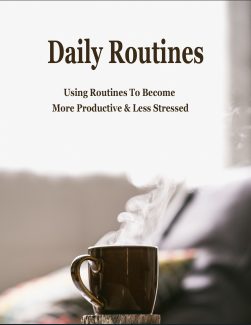
 License Type: Private Label Rights
License Type: Private Label Rights  File Type: ZIP
File Type: ZIP
 SKU: 63752
SKU: 63752  Shipping: Online Download
Shipping: Online Download
Sample Content Preview
How Routines Help You Become More Productive and Less Stressed
Mark Zuckerberg wears a grey t-shirt and jeans every day. Barak Obama always wears a grey or navy suit. Fashion executive Jenna Lyons always eats the same lunch, while writer Danielle Steele always has the same breakfast. Why are these famous and successful people so "boring"? The answer is, they’ve learned that creating a simple daily routine to cover the basic stuff of life leaves them free to work on the important, interesting and creative challenges that make up their life work.
Each day, we are forced to make thousands of decisions - from what to eat, to what to wear, to what to buy. By streamlining some of those decisions into simple, repeatable routines, we can free up time and energy to do things that really matter to us. Read on to learn more about the power of routines, and how they can help you be more productive and less stressed.
=> What Is a Routine?
A routine is any set of actions that are repeated, habitually and without much thought. Routines come in different sizes. They can be as small and simple as the few keystrokes it takes to turn on and unlock your computer, or as large and complex as the daily schedule that keeps you and your family fed, cleaned, clothed, and attending your work, school, and leisure activities.
For most of us, our days are made up of various routines, stitched together. We have a routine upon waking, a routine for getting to work, a routine we do when we get to the office, a routine at the gym, and so on.
By their very nature, routines happen on autopilot, freeing our minds for other things. After all, can you remember in detail exactly how you got to work this morning? Or did you just get there somehow, without really remembering all the steps? If you are like most people, your commute to work happens automatically. You walk to the bus or pull onto the highway while thinking about other things. It’s precisely this automatic nature of routines that makes them powerful. Once we make something a regular habit, we no longer have to concentrate on it.
So, the key to harnessing the power of routines is in recognizing those portions of each day that have become routine. The next step is to analyze those routines. Are they helping you, or hurting you? Recognize what works and what doesn’t, then change your routine to improve your life in whichever way you choose - whether you want to finish your novel, get in shape, organize your life, or just have more time for your kids.
=> Examples of Routines That Work
Many successful and creative people have harnessed the power of routine to get their work done.
Early to Bed, Early to Rise, Early to Create a Bestseller
While many writers disdain the tyranny of "office jobs", some of the most successful writers in the world maintain stricter schedules than most bosses would ever hold them to. For example, Japanese writer Haruki Murakami gets up at 4 am every day and writes for five or six hours. In the afternoon, he runs, swims, or both, then reads and listens to music. He then goes to sleep every day at 9 pm. Murakami maintains this schedule for six months to a year at a time, while he is working on each book.
Even more disciplined than Murakami is American novelist Danielle Steele, who has written 179 books and counting. Steele is at her typewriter every single day by 8:30 am, nibbling on the same breakfast each day: toast and a decaf iced coffee. She keeps typing for hours, claiming to work as much as 24 hours straight when the words are flowing. Note that while this particular schedule may work well for Steele, sleep experts recommend that adults get at least seven to eight hours of sleep every night in order to be as healthy and productive as possible.
Boring Outfits, Creative Minds
While many creative professionals and entrepreneurs take wild risks in their work, in their personal lives they trust in a regular routine to relieve stress and free up mental space for more important decisions. Choosing a daily uniform is one common way that creative people limit the decisions they have to make each day.
We mentioned Facebook founder Mark Zuckerberg, who is famous for his limited wardrobe of grey t-shirt, jeans, and a hoodie. While he has been seen in a suit on rare occasions, he mostly sticks to his uniform. He claims that by always wearing the same thing, he reduces the number of decisions he has to make in a day so he can focus on more important matters.
While Mark Zuckerberg’s wardrobe is particularly limited, he isn’t alone in limiting his clothing choices. Designer Vera Wang, despite creating some of the most beautiful and extravagant wedding dresses in the world, limits her own wardrobe to a handful of basics, all in black. Designer Michael Kors also keeps to a sleek black wardrobe of blazer, t-shirt, pants and loafers.
Simple Meals Save Time
Many people tend to eat the same breakfast and lunch day after day, but Norwegians take "boring" meals one step further. In Norway, almost everyone brings exactly the same type of lunch to work each day, and this habit may be one reason why Norway has one of the highest scores for quality of life in the world. Everyday around noon, almost all Norwegians reach into their packs for their matpakke, a stack of several slices of brown bread with a thin layer of butter and a slice of cheese, meat pate or smoked salmon. This stack of open-faced sandwiches is always simply wrapped in brown paper.







